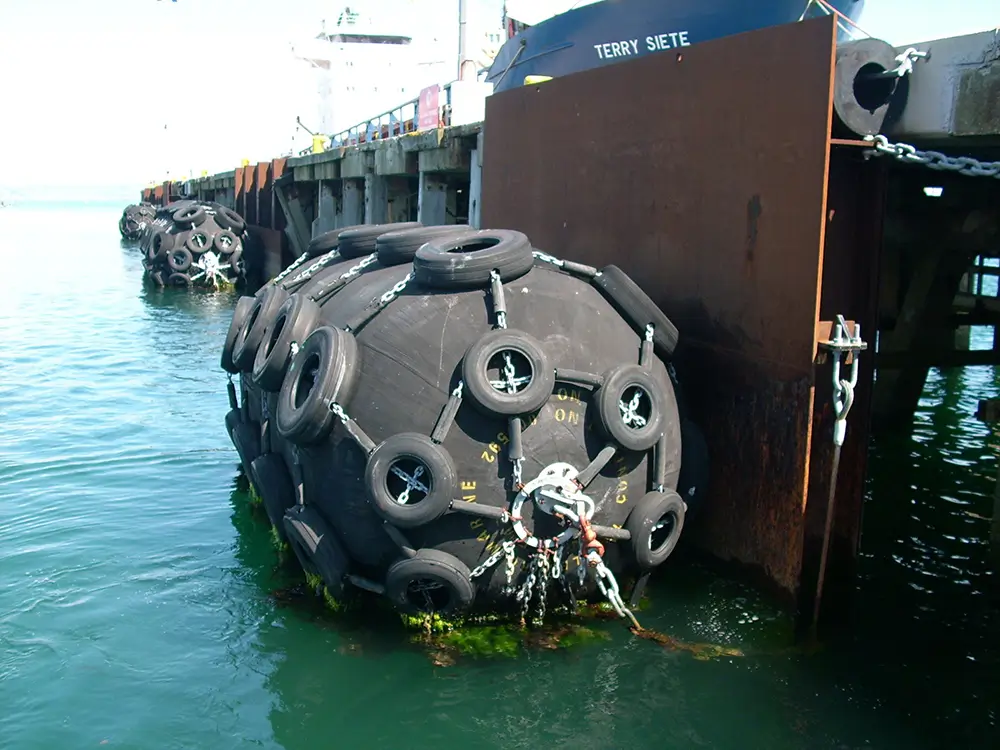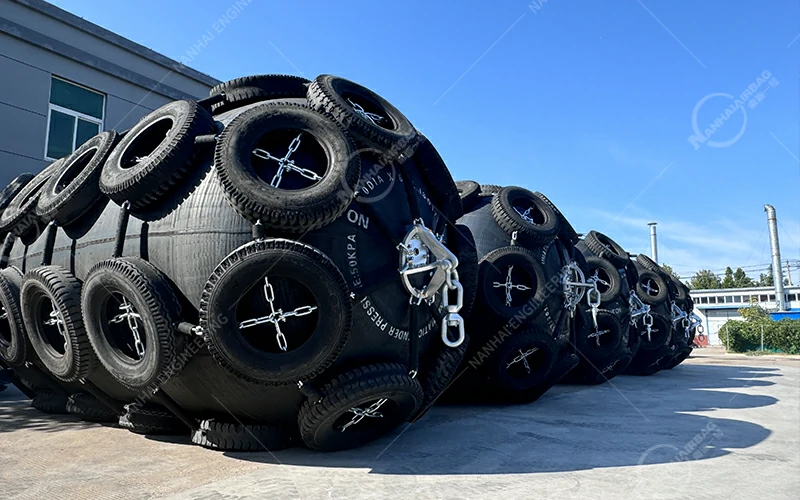هل تحتاج الوسائد الهوائية التي تم إصلاحها لإطلاق السفن إلى ضغط نفخ أقل؟
08/26/2025وسائد إطلاق السفن الهوائية: الاحتياطات الرئيسية
08/27/2025ما الذي يجب الانتباه إليه عند تركيب المصدات الهوائية؟
عندما يتعلق الأمر ب المصدات الهوائيةفإن التركيب المناسب لا يقل أهمية عن اختيار الحجم والمواصفات المناسبة. لا يمكن أن يوفر الحاجز الذي يتم تركيبه بشكل سيئ الحماية المثلى وقد يتسبب في إلحاق الضرر بسفينتك أو بالرصيف. سواء كنت مالك سفينة أو مشغل ميناء أو مهندس حوض سفن، إليك النقاط الرئيسية التي يجب الانتباه إليها قبل وأثناء وبعد تركيب المصدات الهوائية.

1. الأخطاء الشائعة في التركيب وعواقبها
على الرغم من أن مصدات مطاطية تعمل بالهواء المضغوط مصممة لتكون موثوقة للغاية, يمكن أن يؤدي التركيب غير السليم إلى الإضرار بأدائها وسلامتها. إليك بعض الأخطاء الشائعة التي يجب عليك تجنبها:
1.1 سلاسل طويلة جدًا
إذا كانت السلاسل المستخدمة لتأمين الحاجز طويلة جداً، قد يكون الحاجز الميل بشكل مفرط أثناء الرسو. وهذا يؤدي إلى توزيع القوة غير المستقر ويزيد من خطر خدش طلاء الوعاء أو حتى إتلاف الحاجز نفسه. قم دائماً بقياس طول السلسلة وضبطها بعناية.
1.2 ارتفاع الرفرف غير الصحيح
إن تركيب الحاجز مرتفعًا جدًا أو منخفضًا جدًا يعني أنه لن يتماشى بشكل صحيح مع هيكل السفينة أو جدار الرصيف. ونتيجة لذلك، يفشل الحاجز في امتصاص الطاقة بفعالية ولا يمكنه توفير الحماية الكافية.
1.3 تجاهل ضغط التضخم
تم تصميم المصدات الهوائية لتعمل ضمن نطاقات ضغط محددة.
- النفخ الناقص → يقلل من المرونة، مما يتسبب في ضعف امتصاص الطاقة.
- التضخم الزائد → يزيد من خطر الانفجار، والذي يمكن أن يكون خطيرًا للغاية.
تحقق دائماً من ضغط النفخ الأولي على جسم الحاجز واتبع تعليمات الشركة المصنعة.
1.4 ملامسة الأدوات الحادة
أثناء التركيب أو التشغيل، تجنب ملامسة نقاط اللحام أو الحواف المعدنية الحادة أو الأسطح الكاشطة الأخرى. حتى الخدش الصغير يمكن أن يضر بأداء الحاجز وعمره الافتراضي.
1.5 ضعف التثبيت أو عدم وجود شبكات واقية
بدون سلاسل التثبيت، والأغلال، وشبكات الإطارات المناسبة، يمكن أن يتآكل الحاجز بشكل أسرع. تساعد شبكات الإطارات الواقية أيضاً على توزيع القوة بالتساوي وتمنع تلف السطح أثناء الرسو.
2. التحضير قبل التركيب
قبل فك التغليف وتركيب المصدات الهوائية, تأكد من أن لديك مساحة عمل آمنة ومناسبة:
- اختر منطقة مسطحة ومفتوحة ونظيفة لتفريغ مصدات مطاطية تعمل بالهواء المضغوط. يجب أن يكون الموقع محمية من الرياح وبعيدًا عن أي أنشطة القطع أو الطحن أو السفع الرملي.
- قم بإزالة أحزمة التغليف تثبيت المصدات على المنصات أو الدعامات الخشبية. قم بفك المصدات بعناية حتى يمكن نفخها بحرية.
- احتفظ بالرفارف بعيدًا عن الأجسام الحادة لمنع التلف العرضي
- تحضير الكتل الخشبية أو الأوتاد لمنع الرفارف من التدحرج أثناء النفخ.
3. إجراء التضخم الصحيح
يضمن لك النفخ المناسب أداء المصدات الهوائية كما تم تصميمها. اتبع هذه الخطوات بعناية:
- تحقق من ضغط النفخ الأولي
ارجع إلى ملصق الحاجز. الضغوط الأولية النموذجية هي 0.5 كجم/سم² أو 0.8 كجم/سم² حسب الطراز. - استخدم مقياس ضغط معايرة
استخدم دائمًا مقياس ضغط موثوقًا به وتأكد من أن ضاغط الهواء مزود ب نظام التجفيف لمنع الرطوبة من دخول الرفرف. - فهم أنواع الصمامات
بالنسبة للرفارف الأكبر من قطر 2.5 متر, a صمام الأمان عادةً ما يتم تركيبها لمنع الضغط الزائد. - تضخيم تدريجي
ابدأ النفخ ببطء وراقب الضغط باستمرار حتى يصل إلى المستوى الموصى به. - التثبيت وإعادة الفحص
بعد الوصول إلى الضغط المستهدف, توقف عن النفخ وانتظر حول 15 دقيقة حتى يستقر الهواء. من الطبيعي حدوث انخفاض طفيف في الضغط. قم بتعبئته إذا لزم الأمر حتى تصل إلى 0.51 كجم/سم² أو 0.81 كجم/سم². - تأمين الصمام
افصل تركيبات الخرطوم وقم بتثبيت غطاء الصمام بإحكام.

4. المناولة الآمنة والتركيب الآمن
المصدات الهوائية كبيرة وثقيلة، لذا فإن المناولة الآمنة ضرورية:
- استخدم رافعة شوكية بأغطية واقية عند تحريك الرفارف.
- عند الرفع, إرفاق السلاسل إلى شبكات الإطارات المدمجة أو عروات الرفع - لا ترفع الحاجز من جسم السيارة أبداً.
- احتفظ بالرفرف بعيداً عن الحواف الحادة في جميع الأوقات لتجنب الجروح والثقوب.
5. الفحوصات النهائية قبل التشغيل
بمجرد أن المصدات تم تركيبها، قم بإجراء فحص نهائي:
- تحقق من ضبط السلاسل على الطول الصحيح.
- تأكد من محاذاة ارتفاع الحاجز بشكل صحيح مع السفينة والرصيف.
- أعد فحص ضغط الهواء للتأكد من مطابقته للقيمة الموصى بها.
- افحصها بحثاً عن أي تلف أو تسريبات مرئية.
خاتمة
التركيب الصحيح لـ المصدات الهوائية تؤثر بشكل مباشر على أدائها ومتانتها وسلامة عمليات الرسو الخاصة بك. من خلال تجنب الأخطاء الشائعة، وإعداد مساحة العمل بشكل صحيح، واتباع إجراءات النفخ والمناولة الموصى بها، يمكنك زيادة عمر المصدات إلى أقصى حد وحماية سفينتك من الأضرار غير الضرورية.
الأسئلة الشائعة حول تركيب المصدات الهوائية
1. ما مقدار الضغط الذي يجب أن أنفخ به المصدات الهوائية؟
تتطلب معظم المصدات الهوائية ضغط نفخ أولي قدره 50 كيلو باسكال أو 80 كيلو باسكالحسب نوع الحاجز. اتبع دائمًا مواصفات الشركة المصنعة واستخدم دائمًا مقياس ضغط معايرة لتجنب التضخم الزائد أو الناقص.
2. هل يمكن أن يؤثر طول السلسلة على أداء الحاجز الهوائي؟
نعم. السلاسل الطويلة جداً يمكن أن يتسبب في أن يتسبب الحاجز إمالة أو المناوبةمما يؤدي إلى توزيع القوة غير المستقر وحتى خدوش على طلاء السفينة. تأكد من اتباع طول السلسلة الموصى به أثناء التركيب.
3. كم مرة يجب فحص المصدات الهوائية بعد التركيب؟
من الأفضل أن فحص المصدات الهوائية قبل كل عملية إرساء. تحقق من:
- ضغط النفخ المناسب
- تسربات الصمامات
- شد السلسلة وطولها
- تلف السطح
تساعد عمليات الفحص المنتظمة على إطالة عمر الحاجز وضمان التشغيل الآمن.
4. ماذا يحدث إذا كانت الرفارف الهوائية غير منتفخة بشكل كافٍ؟
يمكن أن يؤدي نقص الانتفاخ إلى الضغط الزائد أثناء الرسو، مما يقلل من القدرة على امتصاص الصدمات و المخاطرة بحدوث ضرر هيكلي. حافظ دائماً على المصدات ضمن نطاق الضغط الموصى به من الشركة المصنعة.
5. هل تتطلب المصدات الهوائية تخزيناً خاصاً قبل التركيب؟
نعم، قم بتخزين المصدات الهوائية في بارد وجاف ومظلل المكان. احتفظ بها بعيدًا عن أشعة الشمس المباشرةوالأشياء الحادة والمواد الكيميائية لمنع الشيخوخة المبكرة أو التلف المبكر.
6. أين يمكنني العثور على إرشادات مفصلة للتركيب؟
يمكنك الرجوع إلى معايير السلامة الخاصة بالمنظمة البحرية الدولية و PIANC أو كتيبات التركيب الخاصة بالشركة المصنعة. للحصول على الدعم الاحترافي والمنتجات الموثوقة، يمكنك أيضًا الاطلاع على نانهاي المصدات الهوائية.
